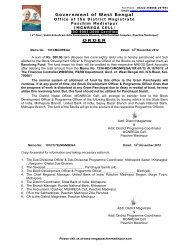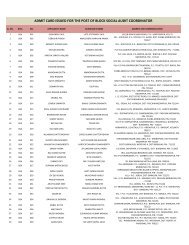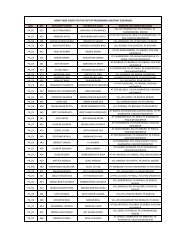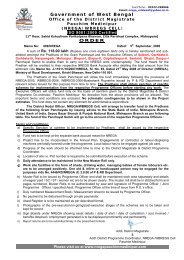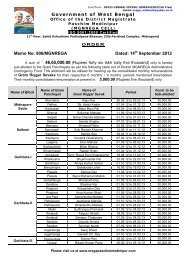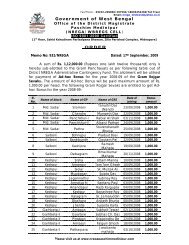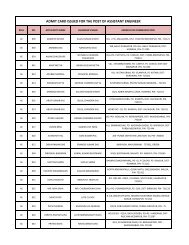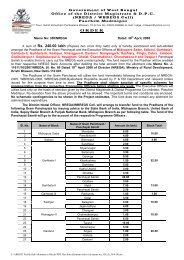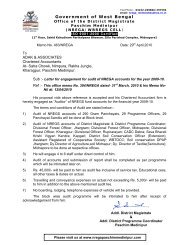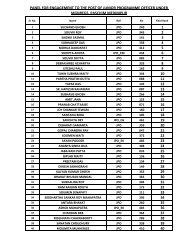Untitled - nrega, paschim medinipur
Untitled - nrega, paschim medinipur
Untitled - nrega, paschim medinipur
Create successful ePaper yourself
Turn your PDF publications into a flip-book with our unique Google optimized e-Paper software.
IntroductionPaschim Medinipur is the second largest district in West Bengal with a totalpopulation of 59 lakh. It lies at the extreme South-Western corner of West Bengal andshares its boundary with Balasore and Mayurbhanj district of Orissa, Purba Singbhumof Jharkhand and Bankura, Hooghly, Purba Medinipur districts of West Bengal. It has29 blocks, 290 Gram Panchayats, 3086 Gram sansads, 8735 mouzas and 10 lakhhouseholds. SC and ST consist of 1/3 of total population. 45% of total households arebelow poverty line and half of total population is either small or marginal farmer.National Rural Employment Guarantee Act, 2005 was launched in the district on02.02.2006. In the initial year we had two major challenges - IEC, i.e. making peopleaware of their right to employment and the other was scheme implementation part. Thebiggest hindrance in implementation of schemes was non-availability of job supervisors:Engaging labourers as per allocation of job issued by Gram Panchayat, recordingattendance on each morning, demarcation of work site to group of labourers,supervising labourers, arrangement of work site facilities etc were not easy task.At the beginning of the programme, on an average there were 4-5 persons ineach Gram Panchayat who were capable to take responsibility of job supervisorsagainst demand of 10-12 supervisors in each GP. Due to paucity of job supervisors, wehad to restrict Gram Panchayats to take 4-5 schemes at a time, though there was hugedemand for job. As a result, expenditure and persondays provided per House Holdduring 2006-07, 2007-08 and 2008-09 were not substantial.The BackdropPaschim Medinipur district has a rich heritage of SHG movement. There are28,000 SGSY groups and 20,000 NABARD groups in the district. We thought toharness this huge workforce for MGNREGA. We selected at least one SHG in eachGram Sansad. Criterion was Grade I passed and at least one member of the group hadpassed class X. Thus, 3086 groups were selected. Instruction was given to Blocks andGPs that 1 st April, 2009 onwards each and every scheme in the district should besupervised by SHG members. At the initial stage there was doubt in many cornerswhether SHG members would be able to shoulder this responsibility. But we were firmin our decision and emphasized on training for capacity building of SHG members. We
prepared a movie on duties of SHGmembers as job supervisor. Alsoprepared training materials in Bengalilanguage. We trained up BlockDevelopment Officers & Joint BlockDevelopment Officers who impartedtraining to SHG members in 2 phases.Management of schemes underMGNREGA by SHG members - wasan experiment which was made for thefirst time in the state.ObjectivesWe had four objective behind this decision –a) IEC - In the initial year of introduction of MGNREGA, we did publicity ofMGNREGA by means of wall writing, flex, miking, awareness meetings, posters, audiocassettes and so on. But we felt that the crux of the problem lied within the govt.machinery. PRI members and govt.officials were not confident that ifpeople demanded employment,they would be able to provide job.Thus, they used to suppress theinformation that MGNREGAprovides 100 days guaranteedemployment to each household.We wanted to reach each & everyHH to make people consciousabout their right to employment and encourage them to submit demand of job.Accordingly, we printed lakhs of Form 4A (demand for employment) and distributed toSHG members requesting them to approach each & every HH and ask whether theywere in need of job. Even, we instructed SHG members that if any HH was found to beilliterate, they should help them to fill up application form. Then, SHG memberscollected all such filled in application forms and submitted to concerned GramPanchayat. In 2009-10 almost 1 lakh demand for employment were deposited in GPsthrough SHG. This strategy helped in two ways - to break bureaucracy and makingpeople conscious about their right to employment.
) Imbibe dynamism in the programme - As stated earlier, in the initial yearsnon-availability of job supervisors was the main hindrances in implementation ofMGNREGA. Gram Panchayats were not in a position to take up more than 5-6schemes at a time. This problem made them inconfident that if people startedsubmitting demand of employment they would be able to provide employment. Afterintroduction of SHG as job supervisor in each Gram Sansad, GP is confident thatdemand of employment can be met up. Now more number of schemes are started at atime which results in more than double expenditure employment per HH in 2009-10than that in 2008-09.c) Transparency - Dissemination of information to villagers regarding cost involved,expenditure, mandays generation etc is now more smooth through a group of 10/12persons.d) Empowerment of women - Theempowerment of women of these SHGsbecomes possible by their strong contactand association with different institutionsand Govt. units like Block, GramPanchayat, Bank and Post Office. Generally women SHGs are working as jobsupervisor under MGNREGA in our District.These groups are showing tremendousinterest for linkage with other organizationsand institutions. For their roles andresponsibilities as Job supervisor underMGNREGA, they are taking field leveldecisions regarding scheme execution atGram Sansad level. This is one remarkableachievement for the society. As economicimprovement is happened throughMGNREGA, so their basic needs for livelihood is being fulfilled and they are becomingconfident enough to do work after improvement of their standard of living.Roles and responsibilitiesAs job supervisor SHG members perform –1. Distribution of blank application form for demand of job among HH, help them tofill up forms, collect those to deposit at GP office.
2. Collection of Muster Rolls and allocation of job form from the PIA3. Meeting the Gram Unnayan Samiti ( beneficiary committee)4. Examining Job Cards of the workers5. Writing their names, job card Nos, payment A/c Nos in the muster Rolls.6. Marking the working area of the workers group7. Intimation regarding date of measurement to the members of the Gram UnnayanSamiti, workers etc.8. Help technical staff to take measurement.9. Fill up the Muster Roll as per instruction of the NS / TA10. Submitting the Muster Rolls to the PIAIn lieu of the above duties they receive one semiskilled wage against 25persondays.SHG and Individual Benefit SchemeWhen the AAP of 2009-10 was prepared, it came into notice that only 2% of totalplan was for IBS. Then, we decided to involve SHG for identification of IBS. Weprinted application forms and handed over to SHG members requesting them to visithouses of SC/ST/BPL/Small & marginal farmers, get forms filled up and submit toGram Panchayats. Within few months 55000 applications were received for IBS.Then plenty was the problem. We had to think how these huge schemes wouldbe implemented and expectations of such huge numbers of poor people would befulfilled. We realized that if role of technical persons can not be minimized in theimplementation part, no substantial progress can be expected. We developed modelestimate in MS-Excel for excavation/re-excavation of ponds, land leveling so thatdependence on technical persons for preparation of estimates can be dispensedwith. We issued instruction to Blocks and GPs that there was no need ofmeasurement of schemes under IBS by technical persons. SHG members were
trained up to record measurement and based on their measurement payment isreleased.Then the scenario changed. Already 7000 schemes under IBS has beenimplemented and total expenditure incurred for this is Rs. 30 crore.OutcomesParticipation of SHG members in NREGS has made sea change in manyaspects like – awareness of people, women participa tion, transparency andaccountability. These positive changes are reflected in terms of expenditures,average persondays generated per HH, implementation of IBS.Year wise comparison of some aspects will indicate that improvement ofperformance is mainly due to participation of SHG members in NREGS.Sl.No.Aspects of 2006-07 2007-08 2008-09 2009-101. Expenditure (in lakh) 5037.72 8474.15 10600 23397.732. Avg. Mandays per HH 16 24 27 523.No. of HH provided100 days job158 1210 2027 103154. Women participation 14% 18% 25% 30%5. Participation of SC 27% 28% 30% 30%6. Participation of ST 26% 25% 24% 25%7. Exp. On IBS (in lakh) NIL NIL NIL 2400Apart from this, impact on women empowerment can be assessed after fewyears. During 2009-10, SHG members across the district earned Rs. 9.25 crore asremuneration for supervising schemes. Such a big amount is going in the hands ofwomen belonging to SC/ST/BPL/Small & marginal families which are used for basicminimum needs like child education, nutrition, livelihood development. Women frombackward section of the society are now regularly visiting Block & Panchayat offices,Banks, Post offices and interacting with Govt. officials, PRI members which gives themself confidence and self reliance.
ConclusionThoughsignificantimprovement has been made inimplementation of MGNREGA byinvolving SHGs but there is no roomof complacency. Still there are somebottlenecks which we need to remove.In some pockets of the district there ismental block among PRI members toinvolve SHG in NREGS. Also, we feelto intensify capacity building of SHGmembers which can be achievedthrough phases of training. We aregiving kits to SHG memberscontaining calculate, measurementtapes and measurement sheets.Hope our relentless effort willbring smile in shy, introvert faces ofthousands of women.




